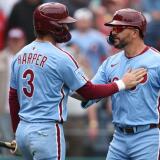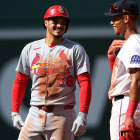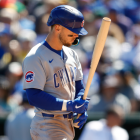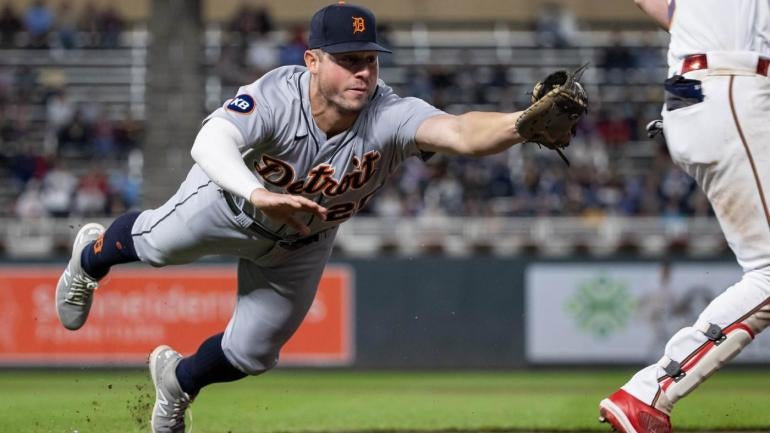
Detroit Tigers first baseman Spencer Torkelson was one of the preseason favorites to win the American League Rookie of the Year Award. Not only did he have the pedigree that stems from being a recent No. 1 pick, but he was assured a wealth of playing time after cracking Detroit's Opening Day roster. (Counting stats tend to win awards, after all.)
Torkelson has indeed played most every day throughout the first third of the season, yet you would be justified in writing off his chances of winning much of anything this fall.
Through Torkelson's first 50 big-league games, he's batted .194/.296/.316. FanGraphs tracks a statistic called wRC+ that adjusts for ballpark and other variables; according to it, Torkelson is tied for the indignity of being the worst-hitting first baseman in the game. This isn't a matter of misleading topline results, either.
To prove as much, let's examine three aspects that explain why Torkelson has disappointed to date.
SPENCER TORKELSON FOR THE LEAD. SHEEEEEESH. pic.twitter.com/NV3YBSTHUN
— Detroit Tigers (@tigers) April 16, 2022
1. Poor component measures
At the risk of oversimplifying hitting, you generally have to do one of two things on a consistent basis to produce at the big-league level: either you hit the ball hard often or you hit the ball at an optimized angle that allows you to find holes in the opposition's defense.
Torkelson has done neither.
Through those first 50 games, Torkelson ranks in the 28th percentile in batted balls hit 95 mph or harder and in the 16th percentile in balls hit between 10 and 30 degrees. Mind you, that's among players with 100 plus trips to the plate, meaning we're not stacking the deck by comparing him to individuals with small samples working in their favor.
Torkelson, to his credit, has drawn his share of walks. Again, though, it's hard to be a productive big-league hitter if you're not doing one of the two things mentioned above on a consistent basis.
2. Underwhelming flyball distance
It would be reasonable to think Torkelson would look good when it comes to average flyball distance based on him having above-average raw strength and this being a results-free measure; it doesn't matter if all of his flyballs went for outs, he would be in solid standing in this department so long as he muscled them a fair distance. Alas.
Torkelson's average flyball distance this season is 292 feet, falling 24 feet shy of the MLB average of 316 feet. That puts him below Nick Madrigal, Isaiah Kiner-Falefa, Johan Camargo, Miguel Rojas, and a slew of other low-wattage hitters. To frame it another way, Torkelson ranks 281st in that category out of 295 qualifiers. He is, nevertheless, ahead of three other Tigers.
To paraphrase Joe Girardi, that's not what you want -- either from your highly touted first-base prospect, or from the rest of your lineup.
3. Confounded by changeups
Sometimes words just get in the way, so here's an image that sums up the header:
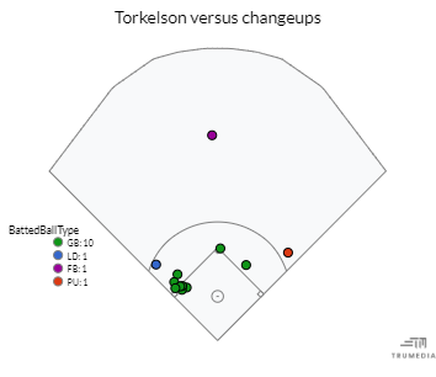
One of the biggest challenges in baseball analysis is incorporating new information about players without being hasty in scrapping your old evaluations. If you're too aggressive in moving off previously held stances, you risk over-adjusting to every hot streak and slump; if you're not aggressive enough, you end up deferring to the larger sample size when a player has clearly changed, for better or for worse.
So, what do you do in a case like Torkelson's? He was supposed to be a relatively safe bet to grow into a middle-of-the-order hitter based on his track record and skill set. Yet he's a third of the way through his rookie season, and there's not much positive to be found. Do you assume that he'll figure out things with additional time? Do you start to think that scouts missed something all these years? Or do you take a position in the middle?
It's not always an easy question to answer. Ditto for the one now facing the Tigers. So at what point, if any, does it make sense to send Torkelson to Triple-A? You can argue that the only way forward for him is to work through his struggles at the big-league level. Being able to make adjustments is often identified as the separator between the good players and the not-so-good players. Torkelson, obviously enough, needs to make some adjustments.
The counterargument is that teams have to be cognizant of what prolonged poor play can do to a player's confidence, and how that can have consequences for their long-term development.
Only Torkelson and the Tigers are positioned to answer whether he'd benefit from a breather in Triple-A. For his sake, here's hoping he can right the ship before it comes to that. Conversations about his game were more fun when they were centered on the brightness of his future rather than the bleakness of his present.
![[object Object] Logo](https://sportshub.cbsistatic.com/i/2020/04/22/e9ceb731-8b3f-4c60-98fe-090ab66a2997/screen-shot-2020-04-22-at-11-04-56-am.png)








